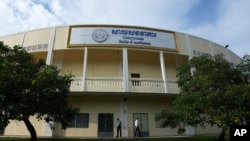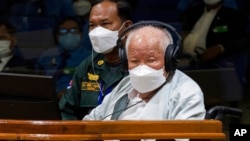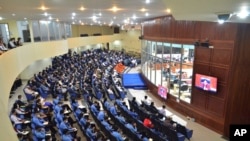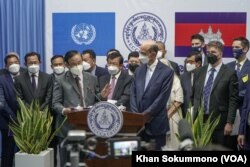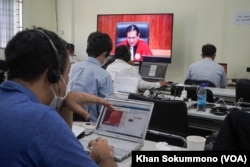WASHINGTON DC — For the past 15 years, a unique experiment in international justice played out in a repurposed Army headquarters on the outskirts of Phnom Penh. Hundreds of lawyers, translators, staffers and service workers made the daily trek west down National Road 4 to carry out the tedious work of trying five — then four, three and two — aging leaders of the genocidal Khmer Rouge.
That chapter of justice for the murder of millions of Cambodians is over now.
In September, the Extraordinary Chambers in the Courts of Cambodia (ECCC) issued its final verdict, rejecting an appeal from Khieu Samphan, the longtime figurehead of the Khmer Rouge, who at 91 is the last surviving defendant from the 1970s regime that pursued an agrarian utopia in Cambodia while driving its subjects often to death.
In December, the United Nations-assisted Cambodian tribunal packed up and handed the building back to the military — Samphan was moved from the court’s jail to die in a state prison.
For the next few years, a skeleton crew of lawyers and staffers working out of offices in central Phnom Penh will complete the “residual phase” of the ECCC, focused mainly on resolving final legal issues and telling Cambodians about the court’s work.
But there’s a larger constellation of professionals and organizations and survivors who are still working toward justice and reconciliation — work that has no end, given the scale of pain experienced in the 1970s and passed on through the generations since.
For nearly two decades, their work has revolved around the tribunal and associated foreign funding for activities ranging from education, intergenerational dialogue, psychological services, public remembrance and engagement in the judicial process. Non-profits have built out programs that not only help heal old wounds, but seek to foster a society with less hate and more capacity to resolve disputes peacefully.
And the leaders of these groups aren’t sure that international partners — which have spent some $337 million on the tribunal alone — will continue to support their work now that “justice” has been served through the tribunal.
“Dealing with the past context is like: Cambodia is no longer a post-conflict country so why do you have to respond to this area? So I think in terms of that particular context, there is a decline in funding support,” said Suyheang Kry, the executive director of Women Peace Makers, a Cambodian non-profit focused on inter-ethnic conflict resolution.
However, her organization still sees a need for building a bridge between remaining Khmer Rouge survivors and future generations of Cambodians, to ensure that the lessons learned from the country’s dark history aren’t lost.
“How are we going to ensure that the younger generations can also bring that; not just about knowing the past, but also how they can also reflect and use that as a tool for them to deal with the present…and build more non-violent types of response,” Suyheang Kry said.
A number of studies have found widespread “secondary trauma” among the children of Khmer Rouge survivors — even if they grew up in the diaspora.
Leakhena Nou, a sociology professor at the University of California Long Beach who has worked extensively with Khmer Rouge survivors, said she still sees signs of unresolved Khmer Rouge trauma throughout Cambodian society, including among younger generations.
“The legacy of the Khmer Rouge continues to live on vicariously through behavioral manifestations like gambling, domestic violence, drug addiction,” she said, noting that violence is often present in everyday language and on social media.
“It just shows that society has not truly addressed the underlying trauma,” Leakhena Nou said.
Starting the Next Chapter
The question facing organizations that have long focused on “post-conflict” work is whether donors will support efforts to face these ongoing challenges, as Cambodia begins the next chapter of its journey toward justice and reconciliation.
For Kdei Karuna (KDK), a peacebuilding NGO that leads community efforts to grapple with the Khmer Rouge’s legacy, the initial signs have been worrying.
“I can see that funds have decreased,” said Minea Tim, Kdei Karuna’s executive director, noting that some programs aligned with the ECCC are phasing out.
“It’s a challenge for NGOs working in this area — dealing with the past — and especially what we have to do after the ECCC,” he added. “Some NGOs that work with this, now they don’t have more funds to do that, and they change to do something else.”
Survivor advocates were hoping that the ECCC’s principal donors might step forward as a group to help fund some of the items on their wish list: ongoing health care, monetary reparations, national education campaigns, physical memorials across the country.
But it’s become clear that donors will keep a narrow focus on its core mandates: finishing the tribunal’s legal process, preserving its archives and informing “civil parties” — thousands of individuals who offered testimony in the trials — of the results of the trials.
Neth Pheaktra, the ECCC spokesman, said the court’s downtown building is also hosting mock trials for students and displaying some of its archives. But it’s unclear if even that will extend beyond the three-year residual phase.
“We will see if we get the mission from the Royal Government of Cambodia and the United Nations with the additional agreement between both sides,” Neth Pheaktra said. “We don’t know yet.”
The NGOs that have long operated around the tribunal face similar uncertainty, but are taking a more active approach to staying alive — and the stakes are high.
With Cambodia’s government largely focusing its funding on the Khmer Rouge tribunal itself, nonprofits like Kdei Karunaand Women Peace Makers form the closest thing Cambodia has to a social safety net for Khmer Rouge survivors, and an advocacy network for their spiritual, psychological and legal needs.
The Transcultural Psychosocial Organization (TPO) has created a mental health care system from nothing over the past two decades, focused largely on Khmer Rouge survivors. The Documentation Center of Cambodia (DC-Cam) has robust programs for archiving history, education and outreach. The Youth Resource Development Program (YRDP) has made sure lessons are passed from survivors to future leaders of Cambodia. And the Tuol Sleng Genocide Museum and Choeung Ek Genocidal Center have become important museums frequented by Cambodians and foreigners alike.
There’s little question that the pool of Khmer Rouge-specific funding is shrinking along with the winding down of the tribunal. The challenge for leaders of these groups is convincing donors that there is still work to do, and that existing organizations are well-suited to do meaningful projects.
Minea Tim of Kdei Karuna said he envisions a more efficient and collaborative network of nonprofits in which overlapping programs are eliminated and each organization narrows its focus to its highest expertise and best use.
“You know each partner has different expertise and I think it's time that we bring this expertise together,” Minea Tim said.
He added that he’s currently trying to facilitate a joint project to foster this collaboration, creating “learning and memory centers” around the country through which different organizations would offer their services.
The end of the tribunal also comes during a generational transition. Many of the remaining survivors of the regime, like its leaders, are old and dying. But the trauma has been passed on to their children and grandchildren, and many of the societal problems that fueled the Khmer Rouge are still very much present.
Suyheang Kry of Women Peace Makers said that’s a compelling reason why the world should continue supporting programs in Cambodia geared toward the younger generations. She said that Cambodian society is seemingly tolerant of diversity, but that some of the xenophobia that fueled the Khmer Rouge is still latent.
“It just needs a bit of a trigger, and it comes right up again,” she said, noting anti-Vietnamese sentiment that emerged amid 2014 anti-government political protests. And she added that political violence and internal strife stretched back long before the Khmer Rouge.
"Hatreds and all that are still deeply rooted," she added. "Education will be one of the keys in how we can celebrate the diversity and stuff, but also definitely we need to learn from the past to really avoid it happening again."
Educating Future Generations
Students in Cambodia’s public schools currently learn about the Khmer Rouge in grades 9 and 12, with curriculum focused on the atrocities of the regime and those responsible. Neth Pheaktra said that the curriculum would be updated in the coming years with information about the tribunal’s verdicts and efforts to deliver justice.
Pheng Pong-Rasy, the head of genocide education at DC-Cam, said the organization is also involved in regional conversations about introducing anti-genocide education into national curriculums, given the dark history of inter-ethnic violence in countries ranging from Cambodia to Indonesia and Myanmar.
“We understand that all younger generations know a lot about Khmer Rouge history, so what they can know next is the process of preventing genocide in the future,” Pheng Pong-Rasy said.
Groups including DC-Cam have built memorial stupas throughout Cambodia, as a symbol of collective remembrance, a site for prayers to those lost during the regime, and a reminder of the dangers of hate and violence.
DC-Cam, through its Genocide Education Project, has also played a leading role in efforts to create post-secondary programs in Khmer Rouge studies and train teachers on new curriculum.
There are separate plans underway to make Cambodia a hub for higher learning about genocide, and international legal efforts to prosecute such crimes.
Germany’s Civil Peace Service (CPS), an arm of the government’s foreign aid arm, has played a pivotal role in developing the civil society groups involved in helping Cambodia grapple with its genocidal past, placing German advisors inside organizations like Kdei Karuna and Youth Resource Development Program.
Though the CPS will continue work in Cambodia, its programs related to Khmer Rouge recovery will end along with the tribunal’s residual phase. However, it is spearheading efforts to create a new regional network that will offer university classes and research material.
Martin Hennings, Civil Peace Service program coordinator in Cambodia, said the Southeast Asian University Partnership would include universities from Cambodia, the Philippines and East Timor — countries that have recently experienced ethnic conflict or war.
“All these experiences can be integrated and shared within the region, in the global south, for future learning and exchange,” he said.
Hennings declined to speculate on to what extent donors would continue supporting NGOs in the peace and conflict space. But he said the organizations are more than capable of operating on their own after almost two decades of support from CPS and others.
“Conflict and peace work never comes to an end. Peace is not a state that you achieve and then it’s done. It’s a process or a state that needs to be constantly maintained,” Hennings said. “So in this regard, it’s very important to continue this work in one form or another.”




